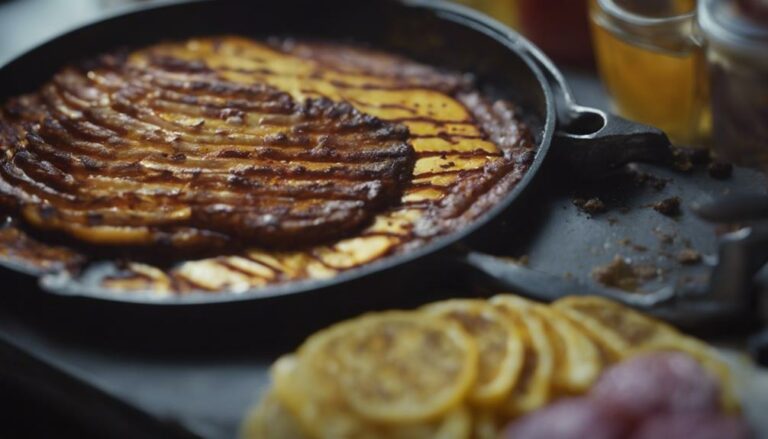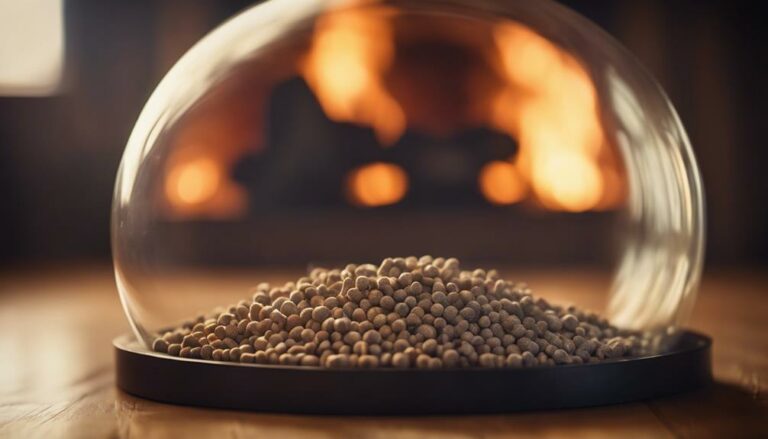As an avid barbecue enthusiast, I’ve come to view the art of slow cooking as a symphony for the taste buds. Each tender cut of meat harmonizes with carefully chosen marinades, rubs, and seasonings to create a mouthwatering masterpiece.
With the low and slow method, the flavors are allowed to dance together, enhanced by the perfect balance of smoke and temperature.
Join me on this journey of elevating BBQ taste and tenderness, as we unlock the secrets to achieving mastery in the art of slow cooking.
Table of Contents
Key Takeaways
- Select well-marbled cuts of meat for enhanced flavor and tenderness
- Marinate or rub meat with herbs, spices, and sauces for at least 24 hours before cooking to enhance flavor
- Control temperature and experiment with different smoking woods for optimal flavor pairing
- Rest meat before carving and serve with complementary sides and sauces for a balanced flavor experience
Choosing the Right Cuts of Meat
I always make sure to select the juiciest cuts of meat for my slow-cooked BBQ, enhancing the flavor and tenderness of my dishes.
When it comes to meat selection, I believe in choosing cuts that are well-marbled with fat. This marbling not only adds depth and richness to the flavor but also helps keep the meat moist and tender during the slow cooking process.
I prefer cuts like brisket, short ribs, and pork shoulder, which are perfect for low and slow cooking methods. These cuts have a good amount of connective tissue that breaks down over time, resulting in melt-in-your-mouth tenderness.
Additionally, I pay attention to the quality of the meat, opting for organic or grass-fed options whenever possible. This ensures that my BBQ not only tastes amazing but also aligns with my values of sustainability and ethical farming practices.

The Importance of Marinades and Rubs
To enhance the flavor and tenderness of my slow-cooked BBQ, I always marinate or rub my meat with a combination of herbs, spices, and sauces for at least 24 hours before cooking. This step is crucial in creating a mouthwatering BBQ experience that will leave your guests begging for more.
While marinades and rubs are both effective techniques, they each offer distinct advantages. Here are three reasons why you should consider incorporating them into your BBQ routine:
- Marinade Alternatives: If you’re looking for a healthier option or want to experiment with different flavors, marinade alternatives such as citrus juices, vinegars, or even beer can infuse your meat with incredible taste.
- Dry Rub Techniques: Dry rubs, on the other hand, are a fantastic way to add a flavorful crust to your meat. They consist of a blend of spices, herbs, and other seasonings that are rubbed onto the surface of the meat, creating a delicious outer layer when slow-cooked.
- Enhanced Tenderness: Both marinades and rubs can help tenderize your meat by breaking down the muscle fibers. The result is a juicy, melt-in-your-mouth texture that will have everyone reaching for seconds.
Mastering the Low and Slow Cooking Method
The key to mastering the low and slow cooking method is patience. Slow cooking allows flavors to develop and tenderize meat to a melt-in-your-mouth texture. To truly elevate your BBQ game, you must understand the art of temperature control and the impact of different smoking woods.
Temperature control is crucial when slow cooking. It is essential to maintain a consistent temperature throughout the cooking process to ensure even cooking and prevent over or undercooking. This requires a reliable thermometer and the ability to adjust the heat source accordingly.
Experimenting with different smoking woods adds depth and complexity to your BBQ. Each wood imparts its own unique flavor profile, from the sweet and fruity notes of applewood to the robust and smoky flavors of hickory. By understanding the characteristics of each wood, you can tailor your cooking to achieve the desired taste.
Table:
| Temperature Control | Smoking Woods |
|---|---|
| Consistent heat | Applewood |
| Reliable thermometer | Hickory |
| Adjusting heat source | Mesquite |
| Even cooking | Cherrywood |
| Prevent over/undercooking | Oak |
Mastering the low and slow cooking method takes time and practice. But with patience, temperature control, and the willingness to experiment with different smoking woods, you can create BBQ masterpieces that will leave your guests in awe. So fire up that smoker, embrace the slow cooking process, and let the flavors unfold.
Selecting the Perfect Wood for Smoking
Experimenting with different smoking woods is essential for achieving the perfect flavor profile in my BBQ. As a BBQ enthusiast, I’ve discovered that the type of wood used during the smoking process can make or break the taste of the final dish.
Here are three key factors to consider when selecting the perfect wood for smoking:
- Flavor: Each type of wood imparts a unique flavor to the meat. Hickory brings a strong, smoky taste, while fruitwoods like apple and cherry add a subtle sweetness. Mesquite offers a bold, earthy flavor that pairs well with beef.
- Intensity: Some woods burn hotter and faster than others. Oak and maple provide a steady, even heat, making them ideal for long smoking sessions. On the other hand, woods like pecan and almond burn slower, resulting in a milder smoke flavor.
- Compatibility: Matching the wood with the meat is crucial. For example, poultry often benefits from the light, fruity notes of apple or cherry wood, while pork and ribs thrive with the robust flavors of hickory or mesquite.
In the world of BBQ, the art of wood selection is a never-ending journey of discovering new flavors and perfecting techniques. So, go ahead and explore different smoking woods to elevate your BBQ to new heights of flavor and tenderness.

Achieving the Ideal Temperature and Smoke Balance
Achieving the ideal temperature and smoke balance is the key to unlocking the full potential of slow cooking. It requires finesse and precision, as temperature control techniques play a crucial role in ensuring the meat is cooked to perfection.
Finding the perfect balance between the amount of smoke infused into the meat is equally important, as it adds depth and complexity to the flavor profile.
Mastering this delicate dance between temperature and smoke is what separates the ordinary from the extraordinary in the art of slow cooking.
Temperature Control Techniques
I’m constantly adjusting the vents on my smoker to maintain the perfect temperature and smoke balance for the best BBQ flavor. Achieving the ideal temperature and smoke balance is crucial in the art of slow cooking.
Here are three temperature control techniques that can take your BBQ game to the next level:
- The Water Pan Method: Placing a water pan in your smoker helps regulate the temperature by absorbing and releasing heat. It also adds moisture to the cooking environment, keeping the meat tender and preventing it from drying out.
- The Minion Method: This technique involves arranging charcoal in a pyramid shape and adding a few lit coals on top. As the lit coals slowly burn down, they ignite the surrounding charcoal, creating a steady and consistent source of heat.
- The Snake Method: In this method, you arrange charcoal in a long, curved line around the perimeter of your smoker. As the charcoal burns, it creates a slow, controlled burn that maintains a steady temperature over an extended period.
Mastering these temperature control techniques, along with experimenting with different smoke infusion methods, will help you achieve the perfect BBQ flavor and tenderness every time. So fire up your smoker, and let the slow cooking journey begin!
Smoke Infusion Methods
With a sprinkle of creativity and a dash of patience, I can enhance the smoky flavor of my BBQ by using both the wet and dry smoke infusion methods. These techniques allow me to infuse my meats with the perfect amount of smokiness, creating a mouthwatering experience for my guests. But the secret to achieving the best results lies in choosing the right wood for smoking. Different woods impart unique flavors, and selecting the appropriate one can make all the difference in the final outcome. Here is a handy table to help you navigate the world of smoke infusion:
| Wood Type | Flavor Profile |
|---|---|
| Mesquite | Bold, strong |
| Apple | Sweet, fruity |
| Hickory | Rich, bacon-like |
Experimenting with different wood types allows me to create a symphony of flavors and elevate my BBQ to new heights. So, grab your favorite wood and let’s embark on a smoky journey of culinary mastery!
Finding the Perfect Balance
To strike the perfect balance, I’ll adjust the temperature and add just the right amount of smoke to my slow cooking process. Slow cooking is an art that requires precision and experimentation. As a BBQ enthusiast, I’ve spent countless hours finding the right equipment and honing my skills to achieve that mouthwatering taste and tender texture.
Here are three key elements that contribute to finding the perfect balance in slow cooking:
- Equipment selection: It’s crucial to invest in high-quality equipment that can maintain a consistent temperature throughout the cooking process. Look for smokers or grills with excellent heat retention and control features.
- Temperature control: Experiment with different cooking temperatures to find the sweet spot for each type of meat. Low and slow cooking at around 225°F (107°C) is ideal for most cuts, while higher temperatures can be used for specific recipes.
- Cooking times: Every piece of meat is unique, and finding the right cooking time is essential. Keep a close eye on internal temperatures and use a meat thermometer to ensure doneness without overcooking.

The Art of Building and Managing a Charcoal Fire
When it comes to achieving the perfect barbecue, the art of building and managing a charcoal fire is essential. There’s something magical about the smoky aroma and the charred, caramelized flavors that can only be achieved by cooking over glowing embers.
Whether you prefer the convenience of gas grills or the traditional charm of charcoal, mastering the techniques of temperature control and adding wood for flavor will elevate your BBQ game to new heights.
Charcoal Vs. Gas Grills
I prefer using a charcoal grill because the smoky flavor it imparts to the food enhances the overall taste. There’s nothing quite like the rich, aromatic essence that comes from cooking over real charcoal.
Here are three reasons why charcoal grills are superior to gas grills:
- Authentic Flavor: Charcoal grills provide that unmistakable smoky flavor that gas grills simply can’t replicate. The charcoal infuses the food with a unique taste that elevates the entire dining experience.
- Temperature Control: Charcoal grills offer more precise temperature control, allowing you to adjust the heat to achieve the perfect level of doneness. You have the freedom to create different cooking zones, giving you more versatility in preparing various dishes.
- Charred Crust: Charcoal grills excel at creating a beautiful charred crust on meats and vegetables. The high heat and direct flame contact result in a caramelized exterior that adds depth and texture to your food.
While gas grills may offer convenience, the unmatched flavor and artistry of cooking on a charcoal grill make it the clear choice for those seeking BBQ mastery.
Temperature Control Techniques
Maintaining consistent temperature throughout the cooking process is crucial for achieving the desired tenderness and flavor in slow-cooked BBQ. As a BBQ enthusiast, I understand the importance of temperature control techniques to ensure the perfect outcome.
There are various methods to maintain consistent heat, such as using a smoker with precise temperature controls, employing the ‘low and slow’ technique, and utilizing a water pan to regulate the internal temperature of the smoker. These techniques allow for the meat to cook slowly and evenly, resulting in juicy and tender BBQ.
Adding Wood for Flavor
Using different types of wood chips, such as hickory or mesquite, enhances the flavor of the BBQ and adds a smoky aroma to the meat. But when it comes to achieving BBQ greatness, why settle for chips when you can use wood chunks?
Here’s why:
- Deeper Smoky Flavor: Wood chunks provide a longer-lasting smoke, infusing your meat with a rich, robust flavor that lingers on your taste buds.
- Consistent Heat: Unlike chips that burn quickly, wood chunks provide a steady source of heat, ensuring a more even cooking process and preventing the risk of flare-ups.
- Extended Cooking Time: With wood chunks, you can enjoy the art of slow cooking, as they burn at a slower pace, allowing you to achieve that perfect tender texture and mouthwatering juiciness.
Utilizing Flavorful BBQ Sauces and Glazes
While experimenting with various BBQ sauces and glazes, I’ve discovered that using a combination of tangy and sweet flavors enhances the overall taste of my slow-cooked meats. The interplay between the tanginess and sweetness creates a depth of flavor that tantalizes the taste buds and keeps me coming back for more.
One flavorful sauce combination that I highly recommend is a blend of apple cider vinegar, brown sugar, and a hint of Worcestershire sauce. The tanginess of the vinegar cuts through the richness of the meat, while the brown sugar adds a touch of sweetness that caramelizes beautifully during the cooking process.
As for glaze application techniques, I’ve found that brushing on the sauce during the last hour of cooking helps to create a sticky, finger-licking coating that locks in moisture and amplifies the flavors.
Mastering the art of flavorful BBQ sauces and glazes truly elevates the taste and tenderness of slow-cooked meats, transforming a simple meal into a culinary masterpiece.
Enhancing Taste With Homemade Seasonings and Spices
I love experimenting with different combinations of homemade seasonings and spices to enhance the taste of my dishes. There’s just something magical about creating your own blend of flavors that perfectly complements your favorite meals. If you’re looking to elevate your cooking game and create unique flavor profiles, here are three homemade seasoning recipes that are sure to impress:
- Smoky BBQ Rub: This blend of smoked paprika, brown sugar, garlic powder, and cayenne pepper adds a delicious smoky kick to grilled meats and vegetables.
- Mediterranean Herb Blend: Combine dried oregano, thyme, rosemary, and lemon zest for a fragrant seasoning that pairs perfectly with roasted chicken and vegetables.
- Spicy Cajun Mix: For a bold and fiery flavor, mix together paprika, cayenne pepper, garlic powder, onion powder, and black pepper. This seasoning is great for adding heat to seafood dishes or jambalaya.
Understanding Resting and Carving Techniques
Understanding resting and carving techniques is essential for achieving mouthwatering BBQ results.
Resting allows the meat to relax, allowing the flavors to meld together and ensuring maximum juiciness.
When it comes to carving, precision is key to ensure each slice is tender and succulent.
Mastering these techniques will elevate your BBQ game to a whole new level.
Resting Enhances Flavor
Resting really brings out the flavor of the meat and makes it juicier. It’s an essential step in the cooking process that should never be overlooked. When you let your meat rest, you allow the juices to redistribute evenly, resulting in a more tender and flavorful bite.
Here are three reasons why resting is crucial for flavor infusion:
- Enhanced Moisture Retention: Resting allows the meat to reabsorb some of its released juices, preventing it from drying out. This ensures each bite is succulent and bursting with moisture.
- Flavor Concentration: During the resting period, the flavors from the seasoning and marinades penetrate deeper into the meat, intensifying its taste. This infusion of flavors enhances the overall dining experience.
- Improved Texture: Resting also allows the meat to relax and become more tender. As it cools down, the proteins relax, resulting in a softer and more melt-in-your-mouth texture.
Proper Carving Ensures Juiciness
Carving the meat correctly is essential for maintaining its juiciness and ensuring a flavorful dining experience. When it comes to serving a perfectly cooked piece of meat, the way it is carved can make all the difference. By understanding the anatomy of the meat and using proper techniques, you can maximize the flavor retention and enjoy a juicy, succulent bite every time.
To illustrate the importance of proper carving, let’s take a look at a comparison table:
| Incorrect Carving | Correct Carving |
|---|---|
| Shredded meat | Uniform slices |
| Uneven thickness | Consistent cuts |
| Loss of juices | Juices retained |
| Dry and tough | Tender and moist |
| Flavor inconsistency | Even flavor distribution |
As you can see, carving the meat correctly allows for even slices, consistent thickness, and retains the natural juices. This results in a more enjoyable dining experience, with each bite bursting with flavor. So next time you’re serving a juicy piece of meat, remember the importance of proper carving to ensure maximum flavor retention.
Knife Skills for Precision
I always strive for perfect slices when using my knife skills for precision in the kitchen. The art of precision knife techniques is essential for any aspiring chef or home cook who desires mastery in culinary craftsmanship. To achieve the perfect cut, one mustn’t only possess the proper knife skills but also prioritize the maintenance and sharpening of their knives.
Here are three key aspects to consider:
- Honing: Regularly honing your knife keeps the blade aligned, ensuring optimal cutting performance. It helps maintain the knife’s edge and prevents it from becoming dull.
- Sharpening: Sharpening your knife is crucial to maintain its cutting ability. Whether you prefer a whetstone, honing rod, or electric sharpener, it’s important to follow the correct technique to restore the blade’s sharpness.
- Cleaning and Storage: Properly cleaning and storing your knives is vital for their longevity. Always hand wash your knives, dry them immediately, and store them in a knife block or on a magnetic strip to prevent damage.
Tips for Serving and Pairing BBQ With Sides and Sauces
One thing I’ve learned about BBQ is that it’s all about finding the perfect sides and sauces to complement the smoky flavors. When it comes to serving and pairing BBQ, there are a few techniques and suggestions that can take your culinary experience to the next level.
To help you navigate through the world of BBQ, here are some serving techniques and pairing suggestions that will enhance the flavors of your slow-cooked masterpiece:
| Meat | Side Dish | Sauce |
|---|---|---|
| Pulled Pork | Coleslaw | Tangy BBQ Sauce |
| Smoked Brisket | Baked Beans | Spicy Chipotle Sauce |
| Grilled Chicken | Cornbread | Sweet and Smoky Sauce |
| Ribs | Mac and Cheese | Honey Mustard Sauce |
These combinations are carefully crafted to provide a balance of flavors that complement each other. The tangy BBQ sauce pairs perfectly with the tender pulled pork, while the smoky chipotle sauce adds a kick to the rich flavor of smoked brisket. Cornbread adds a touch of sweetness to grilled chicken, and the creamy mac and cheese is a comforting side to enjoy with juicy ribs.
Frequently Asked Questions
Conclusion
In the world of slow cooking, BBQ becomes an art form that elevates taste and tenderness to new heights. From choosing the perfect cuts of meat to mastering the low and slow cooking method, every step contributes to a mouthwatering experience.
With the right marinades, rubs, wood, and temperature balance, the flavors intensify and create a symphony for the taste buds. And with homemade seasonings, glazes, and sauces, each bite becomes a burst of deliciousness.
So, embrace the art of slow cooking and indulge in the ultimate BBQ feast.










